Variants
The original Dominant had a windscreen (and matching rear windows) of the same height as the side windows. After 1976 it received a new design of grille and was known as the Dominant I. It remained in production throughout the Dominant's production life as a cheaper alternative to the Dominant II and because the deeper windscreens of the later Dominant marks were incompatible with some front-engined chassis. Some Dominant I bodies had Dominant II style rear windows, and/or headlights and front grilles. Special narrow bodies built for use on the Channel Islands retained the pre-1976 style grille until the end of production.
The Dominant II (introduced in 1976) had a deeper windscreen, rectangular headlights, a different grille and a smaller, flat, single piece rear window.
The Dominant III was designed to satisfy a Scottish Bus Group (SBG) requirement for express coaches, and featured shallow, parallelogram-shaped flat double-glazed side windows similar to those on SBG's previous Alexander M-type coaches. Most Dominant IIIs featured a small Dominant I style windscreen mounted in the lower Dominant II position so as to allow a destination display to be included without breaking the roof line, but others had full-height Dominant II type windscreens. The small high-level windows were designed for SBG's overnight Scotland to London services where quietness was more important than passenger views, but nevertheless some other operators did buy the Dominant III as a touring coach. After being retired from long-distance services many SBG Dominant IIIs were rebuilt with larger Dominant I/II or Dominant IV windows to make them more suitable for general coaching work, and many were given replacement bodies later in life.
The Dominant IV had slightly shallower side windows than those on the Dominant I and II, and these were available with flat glass as an option. Examples were built with all three varieties of windscreen size/position (Dominant I, Dominant II or hybrid Dominant III style). A few Dominant II/IV hybrids were built with stepped window lines, with larger Dominant I/II windows towards the front and shallower Dominant IV windows towards the rear.
Introduction of the Dominant III/IV also heralded the introduction of a new bespoke rear light cluster fitted at a lower level and integrated into the body shape. This was also used on many Goldliners. A lot of these were replaced with other units in later life, probably because they were prone to damage or because spares became difficult to obtain.
Many Dominant bodies were built to a dual-purpose specification featuring bus-type doors and other modifications to make them suitable for OMO (one-man operation) stage carriage services, and thus eligible for the British government's bus grant which subsidised the cost of new service buses. These were known as the Dominant Express with the appropriate mark number where applicable (e.g. Dominant II Express). Some such bodies were actually furnished as service buses with low-backed bus seats, in which form the model was known as the Dominant E (again with mark number where applicable).
The Dominant E was therefore a coach body fitted out as a bus and is not to be confused with the visually dissimilar Dominant Bus which was a purpose-designed bus body built in relatively small numbers from 1974 to 1987. This employed a similar structure to the coach bodies but with flat sides and small windows positioned lower on the body, amongst other differences.
The Goldliner name was first used in 1975/76 for two non-standard one-off bodies based on the Dominant. The first was a high floor body on an early Bedford YMT built as a demonstrator, while the second was an export body with flat, double-glazed windows on a Volvo B58 chassis for Sweden. The name appeared again in 1982 for the Goldliner II, III and IV, which were high-floor versions of the Dominant II, III or IV. All had Dominant II style windscreens, and some coaches not fitted with destination or operator name displays above the windscreen had a stepped roofline behind the cab. As with the Dominant III, many Goldliner IIIs were subsequently rebuilt with larger single-glazed windows or rebodied.
Plaxton is an English builder of bus and coach vehicle bodies based in Scarborough. Founded in 1907 by Frederick William Plaxton, it became a subsidiary of Alexander Dennis in May 2007. In 2019, the maker was acquired by Canadian bus manufacturer New Flyer which then became NFI Group.

Duple Coachbuilders was a coach and bus bodybuilder in England from 1919 until 1989.

Duple Metsec was a bus bodywork builder based in West Midlands of England in the United Kingdom. It usually supplied body kits for bus assembly overseas.
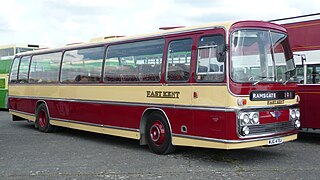
The Plaxton Panorama Elite was a successful design of coach bodywork built between 1968 and 1975 by Plaxton of Scarborough, Yorkshire, England. A wide-doorway variant called the Plaxton Elite Express was also built. Collectively, they are commonly referred to as the Plaxton Elite.

The Plaxton Supreme was a design of coach bodywork built by Plaxton. It was first built, on small chassis only, in 1974, replacing the Plaxton Panorama. On full-sized chassis, it replaced the Panorama Elite in 1975, and was superseded by the Paramount in 1982/3. However, the Supreme continued to be built on the small Bedford VAS chassis until 1986.

The Plaxton Paramount was a design of coach bodywork built by Plaxton. It first appeared at the 1982 British Motor Show and was built until 1992.

The Plaxton Premiere, Plaxton Excalibur and Plaxton Prima were closely related designs of coach bodywork built by Plaxton.

The East Lancs EL2000 is a type of single-decker bus body built on a wide variety of bus chassis by East Lancashire Coachbuilders.

The East Lancs 1984-style double-deck body is a type of double-decker bus body with a step-entrance, built on several different chassis by East Lancashire Coachbuilders in England.

Thomas Harrington & Sons was a coachbuilder in the county of Sussex from 1897 until 1966, initially at Brighton but from 1930 until the end in a purpose built Art Deco factory in Old Shoreham Road, Hove.
H. V. Burlingham was a British coachbuilding business based in Blackpool, Lancashire from 1928 until 1960 when they were taken over by London-based rivals Duple Motor Bodies. Duple initially renamed Burlingham as Duple (Northern) but in 1969 they closed their Hendon factory and concentrated production in Blackpool. Duple coach bodies were built in the former Burlingham premises until Duple itself was liquidated in 1989.

The Seddon Pennine 7 was a mid-underfloor-engined single-deck bus or coach chassis built by Seddon Atkinson between 1974 and 1982.

The Leyland Royal Tiger Worldmaster, sometimes simply known as the Leyland Worldmaster, was a mid-underfloor-engined single-decker bus or single-decker coach chassis manufactured by Leyland between 1954 and 1979.

The Albion Lowlander was a Scottish-built low-height double-decker bus.
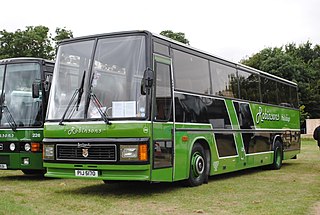
The Duple Caribbean was design of a coach bodywork built by Duple between 1983 and 1986. It replaced the high-floor Goldliner variant of the long-running Duple Dominant range as Duple's premium coach body of the mid 1980s.

The Duple 425 was a coach design built by Hestair Duple in the late 1980s, and briefly by Plaxton in the early 1990s.
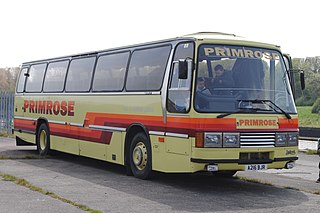
The Duple Laser was a design of a coach bodywork built by Duple between 1983 and 1986. It replaced the long-running Duple Dominant body as Duple's standard medium-height coach of the mid 1980s.

The Duple Calypso was a design of semi-integral coach built by Duple between 1983 and 1984 using running gear from the Bova Europa.
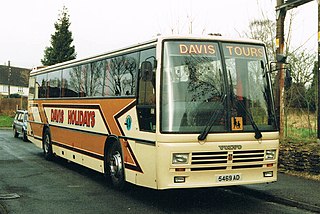
The Duple 300 Series were a range of bus and coach bodywork built by Duple between 1985 and 1989. The range comprised the 3,000 mm high Duple 300 service bus, the 3,200 mm high Duple 320 coach, and the taller 3,400 mm high Duple 340 coach. The 320 and 340 coaches were announced at the Bus and Coach Show at Earls Court in September 1985 as replacements for the previous Laser and Caribbean. Deliveries of these models commenced in 1986, whilst the 300 bus was launched in 1987 as a replacement for the Dominant Bus. After Duple closed down the designs were sold to Plaxton and a small number of additional 320 bodies were built as the Plaxton 321.
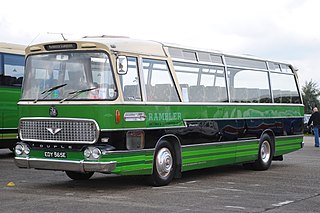
The Duple Viceroy was a type of coach bodywork built by Duple between 1966 and 1972. It was initially launched on lightweight front-engined chassis, but it was latterly built on mid-engined and heavyweight chassis as well. A variant of the Viceroy was the Duple Viceroy Express, which had a bus-type entrance door making it suitable for stage carriage work.
This page is based on this
Wikipedia article Text is available under the
CC BY-SA 4.0 license; additional terms may apply.
Images, videos and audio are available under their respective licenses.






























